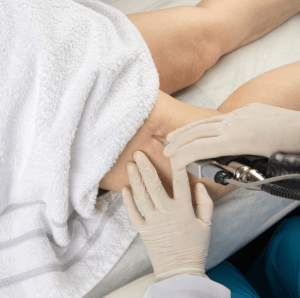What Are The Pros And Cons of Laser Treatment?
 In the past, varicose vein treatment was painful, complicated vein removal that required a lengthy recovery time. Today, we’re blessed with a wealth of minimally invasive options that can successfully correct varicose veins. What could be more modern than laser vein treatment? Let’s look at the different ways lasers are used to treat veins, along with the pros and cons of each technique.
In the past, varicose vein treatment was painful, complicated vein removal that required a lengthy recovery time. Today, we’re blessed with a wealth of minimally invasive options that can successfully correct varicose veins. What could be more modern than laser vein treatment? Let’s look at the different ways lasers are used to treat veins, along with the pros and cons of each technique.
With laser vein treatment, laser technology is used to treat conditions related to the veins. While it may sound like a science-fiction procedure, laser vein treatment has been in use for more than 20 years and has been proven safe and effective. In fact, some laser treatments have a success rate of up to 94 percent. To understand how these procedures work, it’s important to know why varicose veins form in the first place.
The heart pumps blood through the arteries into the extremities, and the veins carry the blood back to the heart. Inside the veins are valves that work to push the blood back through the arms and legs, and sometimes these valves malfunction. When valves are weak or faulty, blood can flow backwards through the veins and pool in the legs, resulting in varicose veins. These swollen veins are not just unsightly but can also be painful. Laser vein treatment, like other non-invasive treatments, works by sealing off the damaged veins so that the blood will reroute to a healthier vessel. There are two types of laser vein treatments:
- Simple laser treatment is completely non-invasive and works on veins near the surface of the skin. It’s often used as a spider vein treatment or for varicose veins that are quite small and superficial. Several sessions are typically required to treat the veins, and these sessions are usually scheduled 6 to 12 weeks apart.
- Endovenous laser treatment (EVLT) is used when varicose veins are extremely swollen. The word “endovenous” means “inside the vein,” and that’s exactly where the treatment is performed. EVLT is done using light sedation or local anesthesia and is performed on an outpatient basis. The doctor makes a small incision in the skin and inserts a catheter, then guides a laser fiber into the varicose vein. The laser applies heat along the length of the vein so that, when the catheter is removed, the vein will shrink and close. The body will naturally reroute the blood to a different vein, and the varicose vein is unlikely to recur.
Laser vein treatment is quick, efficient, painless, and long-lasting, but it does have certain complications and risks. Some patients experience infection, bruising, or bleeding, or even develop blood clots. You may experience tenderness after the procedure, or a burning, prickling sensation. Sometimes, burns occur during this procedure, and sometimes laser treatment can result in a damaged nerve or inflamed veins. These risks are unlikely, as long as you work with an experienced, skillful doctor who has the knowledge and expertise necessary to perform laser procedures. It’s important, then, that you check the doctor’s credentials and note how many years of experience he or she has before committing to any varicose vein treatment.
If you’re seeking the very best care for your spider vein, varicose vein, and other vein issues, trust the board-certified physicians at the Arizona Vein & Laser Institute. Using the most advanced technology, the vascular and cardiovascular surgeons at the Arizona Vein & Laser Institute provide care for all types of venous diseases. With over 40 years of experience, our team of experienced physicians can devise the right treatment plan to address your venous disease problems. For more information contact us through our website.
